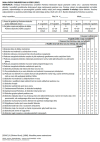Psychometric Evaluation of the Polish Language Version of the Sleep Disturbance Scale for Children (SDSC)-A Pilot Study
- PMID: 40217907
- PMCID: PMC11989841
- DOI: 10.3390/jcm14072458
Psychometric Evaluation of the Polish Language Version of the Sleep Disturbance Scale for Children (SDSC)-A Pilot Study
Abstract
Sleep disorders in children and adolescents are common, affecting approximately 25-50% of children worldwide, yet they remain insufficiently researched. These sleep abnormalities, especially during developmental stages, can lead to various consequences, including emotional and behavioral disorders, academic challenges, mood disorders, and metabolic issues such as obesity. Background/Objectives: The study aimed to psychometrically evaluate a tool for examining sleep disorders in Polish children. Methods: The study involved a randomly selected sample of 42 children, all aged 10, from two primary schools in Poland: one located in a city with over 100,000 inhabitants and the other in a smaller town. Parents were asked to complete the Sleep Disturbance Scale for Children (SDSC) along with a sociodemographic survey. The study assessed reliability using Cronbach's alpha (α) and evaluated the correlation between individual domains using Spearman's rank correlation coefficient (Rs). Results: The pilot group demonstrated very good internal consistency for the entire SDSC scale, with a Cronbach's α value of 0.89, and suitable values for the individual subscales (ranging from 0.69 to 0.83). Additionally, there was a positive correlation between the individual subscales. Conclusions: While this pilot study requires validation with a larger patient group, the results suggest that the SDSC scale could be an effective tool for screening sleep disorders among Polish children.
Keywords: Polish validation of SDSC; SDSC scale; sleep disorders.
Conflict of interest statement
The authors declare no conflicts of interest.
Figures
Similar articles
-
Linguistic validation of the sleep disturbance scale for children (SDSC) in Iranian children with Persian language.Sleep Med. 2014 Aug;15(8):998-1001. doi: 10.1016/j.sleep.2014.03.021. Epub 2014 May 14. Sleep Med. 2014. PMID: 24954442
-
Validation of the sleep disturbance scale for children (SDSC) in infants and toddlers from mainland China.Front Psychiatry. 2022 Nov 10;13:987304. doi: 10.3389/fpsyt.2022.987304. eCollection 2022. Front Psychiatry. 2022. PMID: 36440431 Free PMC article.
-
Application of the sleep disturbance scale for children (SDSC) in preschool age.Eur J Paediatr Neurol. 2013 Jul;17(4):374-82. doi: 10.1016/j.ejpn.2012.12.009. Epub 2013 Jan 22. Eur J Paediatr Neurol. 2013. PMID: 23352289
-
Application of the Sleep Disturbance Scale for Children (SDSC) in infants and toddlers (6-36 months).Sleep Med. 2021 May;81:62-68. doi: 10.1016/j.sleep.2021.02.001. Epub 2021 Feb 10. Sleep Med. 2021. PMID: 33639483
-
Relationship between sleep disturbance and developmental status in preschool-aged children with developmental disorder.BMC Pediatr. 2024 May 30;24(1):373. doi: 10.1186/s12887-024-04857-1. BMC Pediatr. 2024. PMID: 38811876 Free PMC article.
References
-
- Bruni O., Ottaviano S., Guidetti V., Romoli M., Innocenzi M., Cortesi F., Giannotti F. The Sleep Disturbance Scale for Children (SDSC). Construction and validation of an instrument to evaluate sleep disturbances in childhood and adolescence. J. Sleep Res. 1996;5:251–261. doi: 10.1111/j.1365-2869.1996.00251.x. - DOI - PubMed
-
- Stuck B.A., Maurer J.T., Schlarb A.A., Schredl M., Gunter-Weeꞵ H. Practice of Sleep Medicine, Sleep Disorders in Children and Adults. Springer Nature; Cham, Switzerland: 2021. pp. 261–263.
LinkOut - more resources
Full Text Sources



